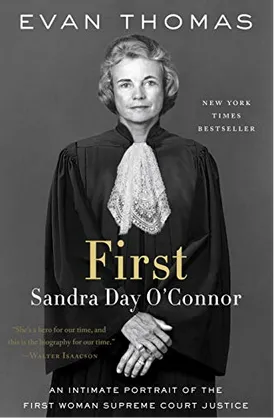First: Sandra Day O'Connor by Evan Thomas
When Sandra Day O’Connor was sworn in as the first female Supreme Court Justice in 1981, she brought to the bench a lifetime of professional and personal experience that uniquely shaped her perspective on justice. Her tenure on the Supreme Court shaped the lives of countless Americans and set an example of service and dedication to the rule of law that few can hope to match.
In his book “First: Sandra Day O’Connor,” author Evan Thomas chronicles the life of this remarkable woman. From her hardscrabble beginnings on the Texas-Mexico border to her tumultuous tenure on the Supreme Court, Thomas provides an up-close view of the life and career of a woman who changed the face of the U.S. legal system.
Raised on a cattle ranch in Arizona, O’Connor spent her childhood outdoors, learning the virtues of hard work and self-sufficiency. After graduating from Stanford Law School in 1952, O’Connor began a successful career as a lawyer in California and Arizona. Despite her considerable talent and drive, O’Connor occasionally encountered gender-based biases that forced her out of certain positions.
Five years after her capture of a seat on the Arizona state legislature in 1973, President Reagan nominated O’Connor to fill the seat on the Supreme Court vacated by Potter Stewart. O’Connor’s appointment came at a time of deep political and social upheaval in the United States, and it stunned the nation—as well as her own family—that a woman of such relative obscurity had been tapped to serve on the highest court in the nation.
Throughout her career as a Supreme Court Justice, O’Connor forged a reputation as a moderate, compromising jurist with a commitment to fundamental fairness. Thomas’s biography offers an insightful snapshot into the thought process of a Supreme Court Justice, detailing her professional decisions and their impacts on Constitutional law.
Although a highly respected figure on the Supreme Court, O’Connor’s moderate views on divisive issues occasionally provoked heated criticism from both sides of the aisle. Despite her willingness to consider all viewpoints, O’Connor’s still firm in her commitment to the values at the core of American democracy—such as the rule of law, judicial restraint, and a belief in the strength of democracy—remain constants throughout her career.
Throughout the book, Thomas captures O’Connor’s humor and strength of character, and his nuanced portrayal reveals the uncommon intelligence and the deliberative process with which she approached the cases that came before her. As Thomas puts it, “her decisions are far more nuanced, careful, and sensitive than the labels ‘conservative’ and ‘liberal’ could ever convey.”
With its thoughtful and engaging prose, Thomas’s “First: Sandra Day O’Connor” presents readers with an opportunity to understand Parliament’s life and legacy. This book is an important contribution to the biographical cannon and will allow readers to gain a greater appreciation for one of the most influential women to serve on the Supreme Court.

